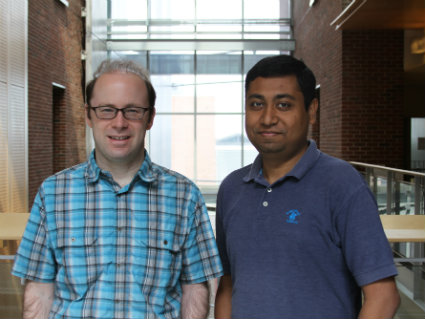 The University of Maryland School of Dentistry’s research team achieved an unprecedented breakthrough with the acceptance of a recent manuscript into the publication Proceedings of the National Academy of Sciences of the United States of America (PNAS).
The University of Maryland School of Dentistry’s research team achieved an unprecedented breakthrough with the acceptance of a recent manuscript into the publication Proceedings of the National Academy of Sciences of the United States of America (PNAS).
This manuscript, titled “Peptide and Proton Driven Allosteric Clamps Catalyze Anthrax Toxin Translocation across Membranes,” is the first time since 1999 that a UMSOD-conceived and produced paper has made it into the presigious journal. This paper was co-authored by Dr. Bryan Krantz, associate professor, and Dr. Debasis Das, a postdoctorate fellow, both in the Department of Microbial Pathogenesis (pictured).
The primary focus of the research centered on the components of the anthrax toxin protein. The anthrax toxin contains three components. One component forms a channel - or pore - in the cell membrane. The other component goes through that pore into the cell. Once that second component (referred to as the ‘substrate’) makes it into the cell, it carries out reactions that disrupts the cell’s functions.
Working from a foundation provided by researchers at the University of California, Berkeley, Dr. Das and Dr. Krantz discovered evidence that this translocation mechanism is under allosteric control. Allosteric regulation is a process wherein proteins transmit the effect of binding at one site to another, often at a location other than the enzyme’s active site. In the case of the Anthrax toxin, when the pore part of the protein binds, the substrate part that is disrupting the cell binds tighter as well, despite being at a different location.
“This tells us how the anthrax pore functions,” said Dr. Krantz, “there are huge implications because this is an entirely new way of thinking about the translocation mechanism.”
Previously, there had been no documented evidence showing that the mechanism of translation carried out by the pore protein was under allosteric control. The importance of this discovery is a major reason why the manuscript was accepted into PNAS, according to Dr. Krantz.
“This is a landmark discovery that may find its way into textbooks,” said Dr. Patrik Bavoil, professor and Chair in the Department of Microbial Pathogenesis, “this is a model for how all proteins, not just the anthrax toxin, translocate across membranes.”
This accomplishment caps off a successful two months for UMSOD research efforts. On May 29th, Dr. Vineet Dhar in the Department of Pediatrics won the Paul P. Taylor award from the American Academy of Pediatric Dentistry (AAPD) for his paper evaluating the evidence of effectiveness of interventions for Early Childhood Carries (ECC).
For Dr. Krantz and Dr. Das, the next steps will include additional research into their discovery through grants awarded by the National Institutes of Health.
Learn more about how to support the School of Dentistry's Department of Microbial Pathogenesis.



